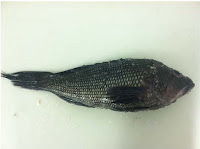Wild Edibles Seafood Sustainability Newsletter
February 18th 2013
MAHI-MAHI
To begin our bi-monthly discussion of sustainable seafood choices we decided to highlight Mahi. Also called “dorado” or “dolphin-fish”, Mahi’s year-round availability and versatility in the kitchen have made it an increasingly popular choice on NYC menus over the past decade. While most diners are familiar with Mahi by now, most don’t realize it also ranks as one of the most consistently sustainable seafood items on the market.
Mahi can be found in any ocean, but for our purposes we prefer it caught domestically when possible, or from Central American waters. A key component to Mahi’s status as a sustainable seafood is the manner in which it is caught. Imported Mahi is typically caught by long-lines. This entails leaving miles of line with hooks periodically dropping down to the necessary depth and then returning later to see what has taken a bite - a la The Perfect Storm. You’ll also remember the shark scene from that film, which illustrates the downside of long-lining: bycatch. Despite bycatch, long-lines do not encounter the sea floor or marine structures like coral reefs, which ultimately keep imported Mahi caught in this manner a sustainable choice.
Domestic Mahi, on the other hand, is often troll-caught or line-caught. Simply put, line or troll catching is when you cast out one fishing line with one rod with the intention of catching one fish or immediately tossing back any bycatch. As you would expect this method isn’t always easiest, but it does virtually no harm to the surrounding environment. For this reason domestically caught Mahi ranks near or at the top of all major sustainability rankings in the industry.
However the key to Mahi’s sustainability is not in the fishing method but rather in the species’ life cycle. Mahi can reproduce at dramatically early ages – 4-5 months old to be exact – which allows the fish to withstand intense stretches of commercial fishing without crippling future generations. Females produce up to 1 million eggs per event and can repeat this process multiple times each year. Furthermore, Mahi populations are constantly on the move. Like other large finfish, Mahi never settle in one area permanently and instead migrate across thousands of miles during their lives in search of prey, the best breeding grounds, and other simple liberties. By constantly being on the move, Mahi populations have been difficult to overfish simply because they swim away too often.
It’s important to remember that Mahi made the transition from sport fish to commercial staple because of its flavor and adaptability to any recipe. Its flesh is firm enough to be grilled but can still flake or handle a dredge and a dip in the fryer with ease. The flavor is mild but doesn’t disappear completely. Mahi are high activity fish – they swim thousands of miles during their lifetime. This results in Mahi having an impressive Omega 3 count to satisfy health conscience diners, while still maintaining a mild, clean flavor. The mercury count in Mahi isn’t negligible, but it still easily measures well below high mercury fish like Tile fish or Mackerel. Mercury accumulates over time as fish near the top of the food chain, like Tile fish or Mahi, consume smaller marine animals. However since Mahi grow so quickly and live short lives, they do not eat nearly as many mercury-laden critters as other large fish, which keeps mercury levels relatively low.
With a myriad of culinary applications, it’s easy to track Mahi’s transformation from a goofy looking sport fish to a household seafood item. Yet considering its year-round availability, competitive price and now the sustainable stamp of approval, it’s a wonder we don’t see Mahi on more menus.
But don’t take our word for it. Here’s what the environmentalists have to say:
BLUE OCEAN INSTITUTE:

MAHIMAHI – POLE AND TROLL CAUGHT
Fast-growing and short-lived, Mahimahi populations can potentially withstand high fishing pressure. No formal population assessments have been done in any region, however, so their overall abundance is unknown.
Mahimahi is likely susceptible to broad-scale environmental change, like changing water temperatures or currents, because of their close association with warm tropical currents.
Pole-and-line and troll fishing methods typically result in low levels of bycatch such as other fish, seabirds and turtles. In addition, pole- and troll-fisheries have a very low or no impact on the sea floor.
MONTEREY BAY AQUARIUM SEAFOOD WATCH


















































